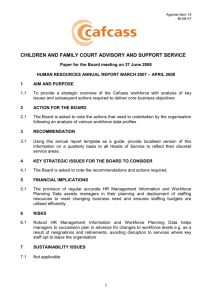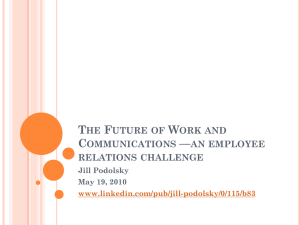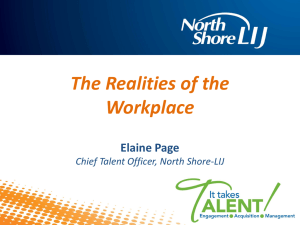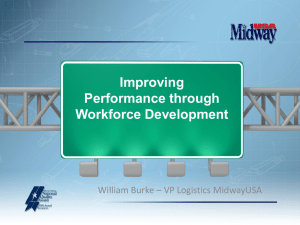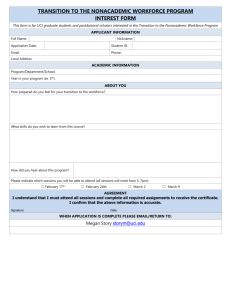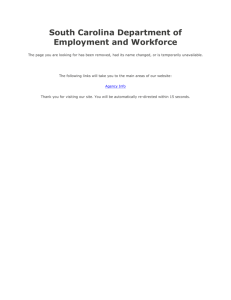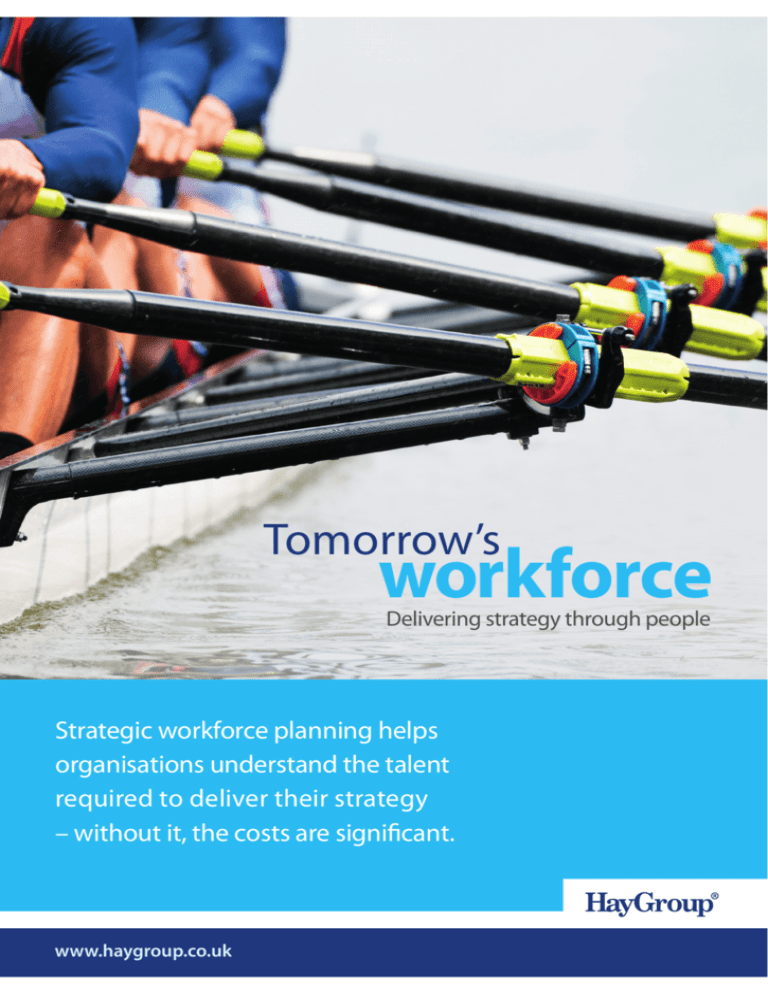
Tomorrow’s
workforce
Delivering strategy through people
Strategic workforce planning helps
organisations understand the talent
required to deliver their strategy
– without it, the costs are significant.
www.haygroup.co.uk
A talented and aligned workforce
is crucial for bringing strategy to
life and ensuring an organisation
delivers on its objectives
Strategic workforce planning
Direct people costs make up an average of
40 per cent of organisational costs. Alongside
this, almost half of the workforce are in complex,
knowledge-intensive roles that are fundamental
to the success and profitability of their
organisations. The cost therefore of getting
workforce planning wrong can be significant.
Integrating workforce supply and demand analysis into the strategic planning
cycle ensures organisations have the ‘five rights’ – the right number of people,
with the right skills, in the right place, at the right level and at the right cost.
This is what we mean by strategic workforce planning (SWP) .
Hay Group has helped many organisations in both the public and private
sectors to clarify and define their future workforce needs and implement
the necessary changes to shape their workforce – to maximise productivity,
effectiveness and profitability. Backed by almost 70 years of proven research
and practice, we understand how to analyse and structure organisations to
shape a workforce that responds to the demands of current and future work,
and ensures delivery of your strategy.
Many industries face critical shortages of
essential talent, while others struggle to
define the shape of the workforce they need
in the midst of major and rapid change.
4 Tomorrow’s workforce
Are you prepared?
All organisations understand that success comes from
having the right people with the right skills aligned to
the work that needs to be done.
However, many industries are in the midst of a major change, as
outlined in the table below, where having the correct workforce
in place is the critical gap between success and failure. Industry
leaders need to be able to address these external challenges and
deliver their strategic plan.
n
n
n
Workforce trends
As work requirements evolve, the demands on the workforce
change too. A number of trends are having an impact on the
shape and expectations of the workforce.
Sector
Ageing – According to the US Census Bureau, Europe’s loss
of “baby boomers” from the workforce and the low birth rate mean
that the active workforce will decline by 29 per cent by 2050.
n
Skills and qualifications gap – despite investment in higher
education, there are significant gaps in skills in scientific,
technical, engineering and maths disciplines. Some 80 per cent
of the talent gap in organisations stem from a lack of appropriately
qualified candidates.
Higher costs for scarce skills – linked to the skills gap, critical
skills attract a market premium for those organisations that fail
to develop and retain key skills.
Changing career patterns and expectations – the traditional
career with retirement in a person’s early sixties has been
replaced with expectations of greater job fulfilment, flexible
employment patterns and a smoother transition into retirement.
Strategic workforce challenge
Oil and gas
There is a growing shortage of geotechnical and petrochemical engineering skills. This is
exacerbated by an ageing workforce and a highly competitive recruitment market.
Finance
A wave of regulatory reform and reorganisation is driving demand for skills in areas such as risk
management and financial analysis.
Energy
New forms of energy production and new regulatory frameworks (such as RIIO in UK) are driving
the need for joint ventures and new skills in areas associated with smart grids, carbon capture
and renewables.
Telecommunications
The rapid shift from 3G to 4G technologies is driving demand for expertise in areas such as network
and radio frequency engineering.
Engineering-based
industries
Industries such as rail and aerospace have seen a shift higher up the value chain, demanding greater
systems engineering and design capability as lower value work is outsourced and off-shored.
Healthcare and
life sciences
An ageing population and the pace of research and technological change is driving a shift in the
required clinical and scientific skills.
Consumer goods
There is a shift from mature to emerging markets to generate growth and margin. A critical success
factor is whether companies can mobilise or recruit the right skills in these parts of the world.
©2012 Hay Group. All rights reserved
Getting it right
Workforce planning is not keeping up with fast-moving workforce
trends. The cost of this failure is high both within organisations and
across the whole economy. For example, a 2008 UK Department of
Health report estimated that hundreds of millions of pounds have
been misspent in developing the wrong types of medical staff for
the UK’s future healthcare needs. Getting the right workforce in place
means addressing the ‘five rights’ (see figure 1).
Delivering strong benefits
Getting your workforce planning right delivers significant
improvements and competitive advantages:
n
n
A company’s employees are
its greatest asset and your
people are your product
Sir Richard Branson, chief executive
and founder, Virgin Group
value improvement and cost reduction – through right
sizing the workforce
n
assurance that business strategy can be delivered
etter productivity – through workforce alignment
b
to operating model
competitive advantage through a more skilled and
innovative workforce
n
n
n
higher quality and timeliness of customer delivery
reater staff engagement and retention and lower
g
levels of stress.
The ‘five rights’
Strategic workforce planning provides the basis for the talent
required to deliver your strategy. To ensure that you have the right
number of people, with the right skills, in the right place, at the
right level and at the right cost, you need to integrate workforce
supply and demand analysis into the strategic planning cycle.
Right size: ensure you have the right number of
Right shape: identify duplication and inefficiency
people in the right roles spending the right amount of
time achieving given outcomes.
to establish the right balance of admin to professionals,
juniors to seniors, experienced staff to new hires.
Right cost: benchmark pay and reward to pay the right price for required skills.
Right place: ensure the required staff resources
Right skills: assess the gaps in the competencies
are available in the right location to meet the
current and future workload.
and skills that will be needed to meet future goals.
Figure 1: key dimensions of strategic workforce planning
6 Tomorrow’s workforce
How Hay Group can help
There are five key ways in which we can partner with organisations
in strategic workforce planning, each supported by a range of
proven and robust analytical tools and methodologies.
We work together with our clients to design a customised solution
combining a range of services depending on what is required to
make their strategies become a reality.
We have an understanding of
the link between jobs, people
and performance that is second
to none.
Workforce scenario planning
Workforce strategy maps
Workforce design to align with
new business operating model
Mapping strategy
to future
workforce
capability
Definition of
ITrequirements
Mapping of SWP
planning processes
SWP system
specification and
implementation
partner
Prototyping of
workforce demand
and supply models
Development of SWP
analysis tools to
integrate with
people data
SWP model
prototyping
and build
Delivering
tomorrow’s
workforce
Building strategic
workforce
methodology
and internal
capability
Figure 2: five ways in which Hay Group helps clients with strategic workforce planning
©2012 Hay Group. All rights reserved
Current workforce
analytics
and market
benchmarking
Age and demographic
analytics
Organisational and job
size / shape analytics
Actuarial and external
reward benchmarks
Design and tailoring
of SWP frameworks
and methodology
Training of HRBPs
and OD specialists
in workforce planning
Design SWP toolkit
support for business
Our unique framework
understand the gaps or overcapacity in the required workforce.
We analyse the organisation’s needs in order to identify the ideal
size, shape, location, skills and cost of their workforce and advise
companies on how to make the necessary changes, implement
the new structures and secure the required capability.
Hay Group’s proven and unique framework for strategic
workforce planning helps organisations to analyse how
effectively their current workforce is bringing their strategy to life.
We examine current structures and benchmark organisations
against their peers and successful companies to help them to
Mission
Vision
Values
Strategic
plan
Objectives
and KPIs
Strategic
capabilities
Operating model
Strategic
intent
Benchmarking
Workforce
analysis
Recommendations
and solutions
International
best practices
Right size
Re-deploy
Organisation
best fit
Right shape
Develop
Development
plans
Right skills
Recruit
Resourcing
Spans of
control
Workforce plans
Interventions
Right place
Internal
productivity
indices
Implementation
Reduce
Leadership
programmes
Succession plans
Right cost
Outsource
Career
development
Figure 3: Hay Group’s strategic workforce planning framework
Case study: streamlining headquarters workforce at a major European airline
With the rise of low-cost airlines and Middle East longhaul carriers, all established European airlines face huge
pressure on margins. Becoming leaner in the central
functions is one option for lowering the overall cost base.
Our client embarked on a substantial cost-cutting project
encompassing all areas of the airline group, including
staffing levels.
Hay Group analysed the current structures, managerial
positions and accountabilities in the corporate headquarters.
We benchmarked HQ staffing levels against other major
companies and airlines.
We challenged the current operating model and defined
organisational design principles. Based on these principles,
we developed new organisational structures for the corporate
headquarters, calculated the optimum number of managers
at each level in the new structure and conducted high-level
job evaluations.
We defined structures that clarified accountabilities,
improved leadership and decision making, and identified
a restructuring potential of about one third of all managerial
positions in the group HQ, bringing a significant reduction in
payroll costs.
8 Tomorrow’s workforce
Hay Group’s workforce tools
Hay Group has a wide range of tools that we use to analyse the
workforce of international and national private and public sector
organisations. These give organisations a mix of qualitative and
quantitative insights into their workforce and its alignment to future
business direction:
n
n
n
orkforce strategy maps – mapping business strategy
W
themes to the operating model and the capability required
to deliver them.
Workforce future scenarios – an interactive workshop
approach to looking at the future workforce under
different external business conditions and internal
company growth strategies.
n
n
n
oints inventory scoring – analysing the overall levels of work
P
in different departments.
n
n
pan and gap analysis – evaluating the levels of
S
organisational work to ensure that jobs are doable
and there are levels of management with appropriate
responsibility for strategy and operations.
Organisational benchmarking – providing benchmarks of
numbers and types of jobs at senior levels in the organisation
against industry sectors.
ctuarial reward modelling – providing whole workforce
A
remuneration modelling and industry benchmarking.
Role fit – enabling systematic assessment of the capability,
knowledge and skills of the whole workforce.
espoke workforce modelling – developing bespoke
B
workforce models to address specific planning issues for
an organisation.
Case study: long term workforce planning at United States Postal Service
With the decline in volume of mail, United States Postal
Service’s (USPS) current workforce far exceeded the level
needed to meet delivery volume and standards, which are
predicted to fall further over the next five to ten years.
Hay Group provided reward and workforce planning
services to USPS, including modelling and projections of
pension and retiree healthcare obligations and funding
costs. Using active census data, we projected that under
normal attrition only 30,000 employees would leave active
service annually over the next few years. USPS concluded
that it needed to reduce the workforce by 180,000
over the next four years. We developed assumptions to
model expected retirement and withdrawal behaviour if
employees were offered voluntary retirement incentives
and showed how this would help USPS align its workforce
to future needs.
Normal attrition
Accelerated attrition
50,000
Retirements
40,000
Disabled
Withdrawls
30,000
Deaths
20,000
50,000
Retirements
40,000
Disabled
Withdrawls
30,000
Deaths
20,000
10,000
10,000
-
2010
2011
2012
©2012 Hay Group. All rights reserved
2013
2014
2015
2010
2011
2012
2013
2014
2015
2016
Bringing together the right information
with the right people will dramatically
improve a company’s ability to develop
and act on strategic business opportunities
Bill Gates, former chief executive and current chairman of Microsoft
Case study: creating a flexible workforce at an engineering services company
This engineering services company employs around
2,000 people performing a variety of engineering and
maintenance tasks. The workforce was siloed and unable
to cope with variable and increasing demand. There was
low productivity and engagement amongst the workforce,
including parts of the management.
Hay Group worked with the client over a number
of months to help transform the workforce and the
organisation. We supported strategic workforce
planning in two major ways:
n
New contract design – based around annualised
and minimum hour contracts and new ways of
working (e.g. resource pools and multi-skilling)
aligned to the workload
Future workforce model – we identified areas and
times of over- and under-capacity and recommended
ways to align the workforce to future patterns of work
to bring substantial cost savings.
n
Overall, we identified savings of more than 10 per cent
of workforce costs (amounting to several million pounds)
and enabled the organisation to free up capacity to take
on new contracts over the next five to ten years.
Why Hay Group?
Hay Group has more than 70 years’ experience in bringing together the organisational, cultural and human dimensions
of business performance. From global financial services and oil and gas organisations, to European-wide retail
companies, and UK engineering manufacturing firms – we help clients from a range of sectors and sizes to transform
their strategy into reality. You can be confident you are partnering with the best.
n
World-class workforce analysis tools – based on decades of job and workforce research.
Industry workforce knowledge – we have analysed and assessed workforces in every major industry sector.
n
Wholly independent – we are privately owned and not linked to particular system providers or recruitment agencies.
n
Truly global – we have more than 10,000 customers and 2,600 staff in 48 countries.
n
For more information
If you would like to understand more about how Hay Group can
help you with strategic workforce planning, please contact:
Paul Lambert
Associate director, Hay Group
t +44 (0)20 7856 7150
e paul.lambert@haygroup.com
m +44 (0)7956 629243
Africa
Cape Town
Johannesburg
Pretoria
Asia
Bangkok
Beijing
Ho Chi Minh City
Hong Kong
Jakarta
Kuala Lumpur
Mumbai
New Delhi
Seoul
Shanghai
Shenzhen
Singapore
Tokyo
Europe
Amsterdam
Athens
Barcelona
Berlin
Bilbao
Birmingham
Bratislava
Brussels
Bucharest
Budapest
Dublin
Enschede
Frankfurt
Glasgow
Helsinki
Istanbul
Kiev
Lille
Lisbon
London
Madrid
Manchester
Milan
Moscow
Oslo
Paris
Prague
Rome
Stockholm
Strasbourg
Vienna
Vilnius
Warsaw
Zeist
Zurich
Middle East
Dubai
Riyadh
Latin America
Bogotá
Buenos Aires
Caracas
Lima
Mexico City
San José
Santiago
São Paulo
Pacific
Auckland
Brisbane
Melbourne
Perth
Sydney
Wellington
North America
Atlanta
Boston
Calgary
Chicago
Dallas
Edmonton
Halifax
Kansas City
Los Angeles
Montreal
New York Metro
Ottawa
Philadelphia
Regina
San Francisco
Toronto
Vancouver
Washington DC Metro
Hay Group is a global management consulting firm that works with
leaders to transform strategy into reality. We develop talent, organise
people to be more effective and motivate them to perform at their
best. Our focus is on making change happen and helping people and
organisations realise their potential.
We have over 2,600 employees working in 85 offices in 48 countries.
Our insight is supported by robust data from over 125 countries.
For more information please contact your local office through
www.haygroup.co.uk



